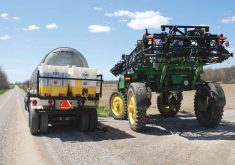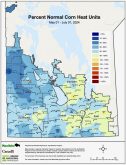Overview
A concentrated push to finish seeding this past week led to a sharp increase in planted acres, with many farms in the Eastern, Central, and Southwest regions finished seeding, while parts of the Interlake and eastern side of the Northwest region remain unplanted. Some reseeding of canola has occurred after crusting events and severe flea beetle damage.
Recent rains have stopped seeding progress once again, and those farmers yet to finish planting are coming to the realization that there will be unseeded acres on their farms this year. Estimates are that over 250,000 acres will be unplanted by the June 20 seeding deadline, concentrated south near Lake Dauphin, the northern Interlake, and adjacent to the Red River, where fields have only recently seen standing water drain away.
Read Also

New ranking elevates Assiniboine College to national research elite
Brandon’s Assiniboine College is 47th in a national ranking measuring research dollars and output at publicly funded institutions in Canada.
As farmers shift mentality to in-crop management, herbicide application is becoming widespread, and calm conditions last week saw many spring cereal and corn fields see their first herbicide application, together with numerous applications of insecticide for flea beetles and cutworms and young grasshoppers in localized areas.
Repeated rains and warm soils have led to widespread nitrogen fertilizer losses, either via leaching or denitrification. In-crop nitrogen-deficiency symptoms are showing up as chlorotic (yellowed) leaf margins, in combination with other symptoms of crop stress due to saturated soils. A drop in nitrogen prices (down approx. 30% from spring highs) may encourage in-crop top-dressing. The rush to seed crops wherever possible led to poorer seedbeds in some cases, which will impact in-season management and harvested yields.
Ag retailers are dealing with inventories of returned corn seed, cancelled soybean orders, and either a tight supply or surplus of canola seed, depending on location. There are a few crops where seeding deadlines can still be met and farmers will attempt to plant as soon as fields dry out after the most recent rains.
Livestock have been turned out to pasture, and forage growth is generally sufficient. Biting insects and mosquitoes are becoming a nuisance for cattle.
Cereals
Spring cereal seeding is nearly complete in all regions, and earliest seeded crops are now at the 3 to 4-leaf stage, and covering ground quickly. Later seeded cereals are emerging well.
Most barley crops are just emerging, while oats are at emergence to 3-leaf stage.
Grain corn development ranges from cotyledon to 3-leaf (leaf-over method).
Herbicide application has become the priority in cereals, with many crops being sprayed last week for lamb’s quarters, kochia, roundleaf mallow, amaranth-species (pigweeds), green and yellow foxtail, and volunteer canola and sunflowers.
Grasshopper nymph feeding damage has been reported in many crops in some pockets of the Central Region, feeding on emerged cereals, corn, and canola. Control measures are being taken.
Fall rye looks excellent across the province, and most crops have been sprayed with a foliar fungicide for leaf disease prevention. Rye crops are headed out.
Winter wheat is now in the jointing/boot stage, and the most advanced fields are starting to head out in the Eastern region.
Oilseeds
Emerged canola staging ranges from cotyledon to 4-leaf, with many fields reaching 2-leaf early this week.
Foliar application for flea beetles is widespread in canola fields, using permethrin as the active ingredient of choice. Flea beetle pressure has been heavy, yet inconsistent, with some fields requiring up to three foliar insecticide applications while nearby fields at similar stages have seen only minor damage.
Farmers reported improved performance from newer insecticide seed treatments over standard package treatments in canola.
Flooded and crusted over fields last week have either recovered with light rains or have been reseeded, with an estimated 15% of canola acres in the Central region being replanted.
Flax crops are mostly seeded, and emerging fields appear in good condition, with earliest fields now 3 to 4 inches tall. Fewer crops have been planted than intended, due to moisture concerns.
Sunflowers have emerged fairly well, stands appear to be average to above-average in density and survivability. Plants are now at VE to V2.
A number of sunflower fields have been sprayed for cutworms, particularly in the Eastern region.
Pulses
Soybeans are now established in most regions, and range from cotyledon (VE) to unifoliate (VC).
Crusting was not an issue for peas or soybeans, and furrow-flipping was visible from the road.
Soybeans have been planted on about 70 to 80% of intended acres, and any further acres remaining have been switched to canola or wheat, with some growers choosing barley or oats as a crop or greenfeed alternative to fewer silage corn acres.
Field pea crops range from emergence to 5th node stage. Pea acres are expected to be between 140-160,000 acres, down from 220,000 acres in 2021 as a result of changing cropping plans due to wet fields.
Dry edible bean planting rapidly increased last week, with 100,000 to 110,000 acres now planted, down approximately 20% of the initial intended acreage in Manitoba.
Forages & Livestock
Forages
Alfalfa stands are doing well, and filling in. Most crops are thick and approaching 12 inches in height.
Hayfields have improved with better growing conditions last week, but less moisture and more heat is needed for continued improvement.
Cattle producers with high-volume forage needs are scrambling to plant silage corn by the June 15 deadline in Area 1, and are looking for more greenfeed acres to make up the expected tonnage shortfall.
Flooded lakeside and marshy pastures are still unusable by cattle, and those producers are forced to find alternatives to continue to provide supplemental feed.
Livestock
Cattle have been turned out, and doing less damage to pastures than initially thought.
A limited start to hay and silage cutting has begun by dairy farmers, cattle producers intend to begin first-cut more broadly as weather patterns stabilize in all regions.
All creeks, streams, dugouts, and sloughs have refilled to capacity, and generally remain within their banks, but water levels remain high.
Regional Comments
Southwest
A drier week allowed many farms to rapidly advance seeding completion, however nearly all fields have patches left unseeded due to wet soils or standing water. Warm temperatures and calm conditions encouraged rapid crop and weed growth over the preceding week, and sprayers were active in fields wherever farm operations permitted. Seeding progress across the region is now 80 to 85% complete.
Quarter-sized hail fell from Glenboro to Cypress River early Sunday morning, damaging emerged corn and canola crops, but most fields will likely recover with some delays. Heavy rains in the past 24 hours have filled ditches and saturated soils in many areas, most notably at Souris, which has received 10 consecutive hours of rainfall totalling over 75 mm. Districts between the TransCanada Highway and PTH 2 (Souris, Virden, Alexander, and Brandon) were more impacted by heavy rains than areas further north (Hamiota, Miniota, Shoal Lake, and Russell), while Minnedosa, Rivers and Rapid City also had significant rain.
Northwest
Good weather continued to see substantial seeding progress across the region, while rain slowed planting on the eastern side of the region again. Seeding progress across the region sits at 85% complete, with the Swan Valley, Roblin, and The Pas districts nearly done, while Ste. Rose area is about 60% complete, followed by Dauphin at 75% complete.
Excessive moisture is hampering field planting and crop growth in the eastern side of the region, while herbicide and insecticide application continues as-needed and as conditions permit on emerged cereal and canola crops.
Central
Warm, relatively dry weather helps push the Central Region seeding completion close to 92% done. Most crops in the region have been planted, and emergence has been good, with some exceptions in fields where water did not drain within 48 hours, some crusted fields, or where flea beetle and grasshopper feeding forced reseeding of canola and some cereals if insecticides could not be applied within a short timeframe.
Hail damaged some crops from Sanford to Domain in last Sunday’s storm, but crops are expected to pull through. Approximately 5 to 10% of fields in the Altona to Morris area, and some near Portage la Prairie will not be planted before the June 20 seeding deadline. Herbicide application has become widespread, as producers are shifting to in-crop management as conditions permit.
Eastern
Rainfall accumulation last week ranged from 6 to 47 mm, with higher amounts in the central and southern districts falling Sunday morning. Crops are emerging rapidly across the region, with good seedling survivability under flooded conditions if water could drain from the field within 48 hours. Dairy farms began a limited forage cut, with most feed intended as silage. Other farms are waiting for weather conditions to stabilize before beginning.
Lots of seeding progress was made last week. Producers are reporting that the majority of acres that were able to be planted are now in the ground. Some acres are reported as unseeded and will likely remain that way due to excess moisture. Seeding progress across the region sits at 95% complete, with about 2% of arable land unlikely to be seeded this year due to repeated rains and wet conditions.
Interlake
Rapid progress in the south Interlake has led to nearly 90% of acres seeded there, while continued wet weather and slow drainage in the northern part of the region has seen about 65% of the crop planted. Overall, regional seeding progress sits at 80% done with considerable variation between farms. A number of farms in the northern districts west of Arborg towards Fisher Branch and Lundar have only a small portion of their farms seeded. Farmers are coming to terms with the reality that many crops will not be seeded this year.
Broadcast seeding canola occurred on approximately one-third of canola fields in the Interlake region. Farmers are managing the compressed season, with emerged crops rapidly progressing, along with weeds as herbicide application has started. Crop emergence is occurring in as little as five days post-seeding due to warm temperatures and adequate moisture.















